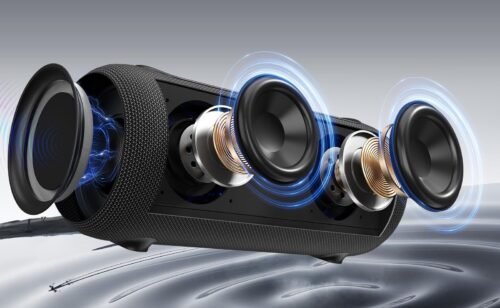Because Even Solitude Sounds Better With Music.
When you’re halfway up a ridge and the world’s gone quiet, the right song can stop you in your tracks. Not because it’s loud — but because it fits. Hiking and backpacking aren’t about shaking the forest with bass. They’re about pacing your breath to a rhythm. Adding a soundtrack to the switchbacks. Letting a podcast carry you through the last few miles.
If you’re carrying it on your back, it better be light, tough, and built to work without babying.
Your Bluetooth speaker has to be the kind of gear that disappears until you need it — and still works when it’s been jostled, rained on, or buried in a pack pocket with your trail mix.
What Really Matters in a Speaker for Hiking & Backpacking
Every ounce counts. So does every square inch of pack space. That means your speaker needs to:
- Be as small and light as possible without sounding terrible
- Withstand water, dirt, snow, and accidental drops
- Have enough battery to last a full-day trek or overnight camp
- Attach securely to a strap, loop, or carabiner
- Sound good at low volume — loud enough for you, not the whole trail
Bonus if it doubles as a power bank, doesn’t have flashing lights, and doesn’t make you wince every time you look at your pack weight.
So, What Should You Buy?
These speakers are built to go the distance — some small enough to clip to your sternum strap, others better stashed in a tent pocket. They’re trail-tested, ultralight, and good enough to make your solo summit a little more cinematic.
Best for Ultralight Backpackers
Our Top Pick
Best for Backcountry Campsites
Best for Battery Life on Long Treks
Best for Rugged Terrain and Rough Weather
Best for Group Treks and Shared Camps
Why Quiet Clarity Matters on the Trail
When you’re deep in the woods, you don’t want a party speaker — you want something that respects the space. That means clarity over volume. Mids that sound natural. A speaker that doesn’t hiss or distort when playing softly. Because out here, everything’s amplified — your footsteps, your breathing, the wind in the trees. Your speaker should blend in, not bulldoze through it.
That’s why models like the SoundLink Micro or Clip 5 work so well — they focus on clean, focused audio that enhances the hike without stealing the show.
How Hikers Actually Use a Speaker
Most of the time, your speaker is clipped to your shoulder strap, daypack, or water bottle pocket. You’re not stopping to set it up — it just needs to work, rain or shine. At camp, it sits in a tent gear loft or on a rock. You want:
- Simple controls you can hit with wet or gloved hands
- A shape that doesn’t roll off a boulder
- No annoying startup sounds or blinking lights
The less you have to think about it, the more it earns its place.
Trail Weight vs. Trail Value
Is it worth carrying a Bluetooth speaker when you’re already counting grams? That depends on your priorities. But for many hikers, a little music or a favorite podcast can push them through tough climbs or give comfort when the trail gets lonely.
That’s why these picks are so lean — they offer something meaningful without asking much in return. And when a speaker can also charge your phone or run for 12+ hours without blinking, it’s not just a luxury — it’s trail insurance.
Smart Power Habits in the Backcountry
If you’re not hiking with solar or a battery bank, battery life becomes a real limitation. Plan ahead:
- Charge fully the night before your hike
- Use airplane mode on your phone to preserve both devices
- Keep the volume low to stretch run time
- Consider doubling up with a power bank speaker like the Tribit if your phone’s already aging out
Even the best speakers won’t last forever without juice, but a few good habits mean you’ll get more miles before needing to recharge.
Final Thoughts
There’s something powerful about walking into the wilderness with just what’s on your back — and still bringing a little comfort along. A good Bluetooth speaker won’t weigh you down or break your flow. It’ll sit quietly, ready to turn a trailhead into a memory, a solo hike into a dance party, or a foggy morning into a soundtrack. Choose the one that fits your style, your pack, and your pace — and let it carry you the rest of the way.










